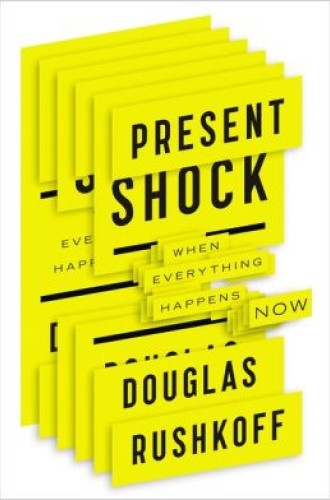Present Shock, by Douglas Rushkoff
Everywhere I look these days people are looking down. Not out or up or over there, but down. And everyone is doing it: my colleagues in meetings at work, my students as they walk to class, the businesspeople who stride by my house every morning on their way to the train, and my own kids whenever they have a minute free. Heck, even the guy standing next to me at the urinal is doing it. What are they looking at? Their smartphones, of course. And what are they doing? Texting and tweeting and Skyping and watching YouTube and playing video games and checking news feeds and selling stock and buying shoes and reading comments by thousands of “friends” they have never met.
But do smartphones and other digital technology make us smarter or happier? Have the recent breakthroughs in communication technology improved the quality of our lives? These are the questions media guru Douglas Rushkoff takes on in Present Shock: When Everything Happens Now. The answer is no—and yes. Rushkoff calls our culture of hyperdistraction “digiphrenia” because new technologies and media reward multitasking and encourage us to be many places at the same time.
Read our latest issue or browse back issues.
After reviewing the history of technology over the last few centuries, Rushkoff focuses primarily on the digital tech boom of the last 20 years and on how it has affected human behavior. The thematic heart of the book is suggested by the title. Recent technology has indeed radically altered how we understand, measure and use time. Rushkoff reimagines a new kind of presence, a multipresence that is seemingly antithetical to any spiritual or religious connotations of the word. This presence is best described as frantic convenience, as “desperate immediacy” and “always-on urgency.” We are “of the moment but not in it,” and this new “nowness” leaves us feeling “distracted, peripheral, even schizophrenic.”
Rushkoff contends that we have been duped into pursuing unrealistic and unsatisfying goals related to time and productivity:
If we could only catch up with the wave of information, we feel we would at last be in the now. This is a false goal. For not only have our devices outpaced us, they don’t reflect a here and now that constitutes any legitimate sort of present tense. They are reports from the periphery, of things that happened moments ago.
Our relationship to time is defined entirely by the technologies we use to measure it, Rushkoff argues. He reminds readers of a great irony: the first mechanical clock had a religious origin. Twelfth-century Benedictine monks needed a way to reliably mark their seven daily prayer sessions. The clock was invented to tell the monks when to ring the bell to call the community to prayer. By the middle of the 14th century the lure of such a clock, of measured time, spread beyond the monastery walls to the world of commerce.
“Arriving on bell towers at the dawn of the industrial era,” Rushkoff writes, “the clock was decidedly more interesting to those looking for ways to increase the efficiency of the new working classes. Ironically, an invention designed to affirm the primacy and ubiquity of the sacred ended up becoming a tool of expansion for the secular economy.” The search for the presence of God was soon replaced by a much greater need—measurement of workers’ presence in the factory. The time clock was invented, workers began punching in and out, and the human being became the human machine. The new field of scientific management was born, and efficiency and productivity began to drive technology.
Rushkoff contends that technology shouldn’t and needn’t control us. Rather, it is a tool that we should use to our advantage: “The opportunity offered to us by digital technology is to reclaim our time and to program our devices to conform to our personal and collective rhythms.” He continues: “Rather than being paced by our technologies, we can just as easily program our technologies to follow our own paces.”
Of course, this is not a new idea, but it is much easier to propose than to practice. Though there is no single answer as to how to stay afloat in the technological tsunami, Rushkoff advises that the solution is found in balance. We must make clear, conscious choices about technology—about how and what and when we watch and read. With balance “we can stop the onslaught of demands on our attention; we can create safe space for uninterrupted contemplation; we can give each moment the value it deserves and no more; we can tolerate uncertainty.”
I’m greatly sympathetic to this aspiration and to Rushkoff’s ideas about how to become more present, but I’m not sure that my twentysomething college students will get it. It seems that many of the big ideas that Rushkoff explores—contemplation, attention, uncertainty, balance—are being reimagined and redefined by a younger generation that understands technology and media in completely new ways. Perhaps now the challenge is to learn from each other across generational lines as we stumble together in an awkward multipresence through the always-new digital frontier.







